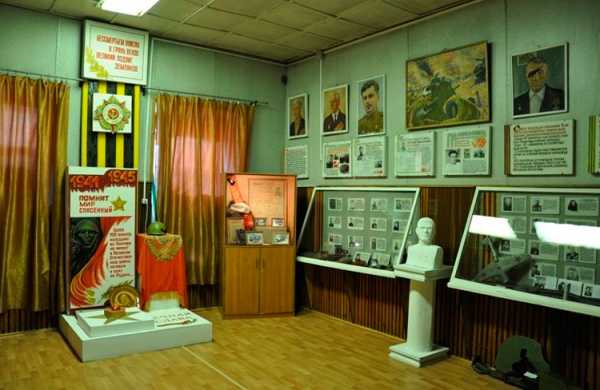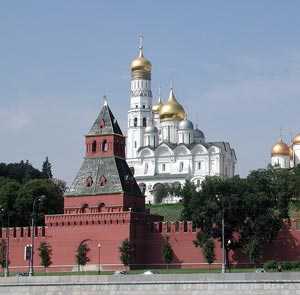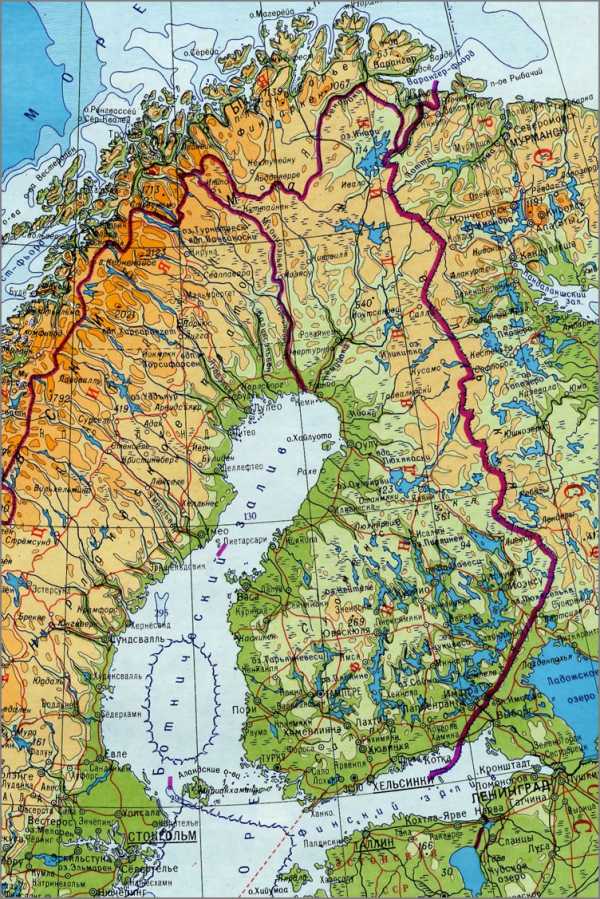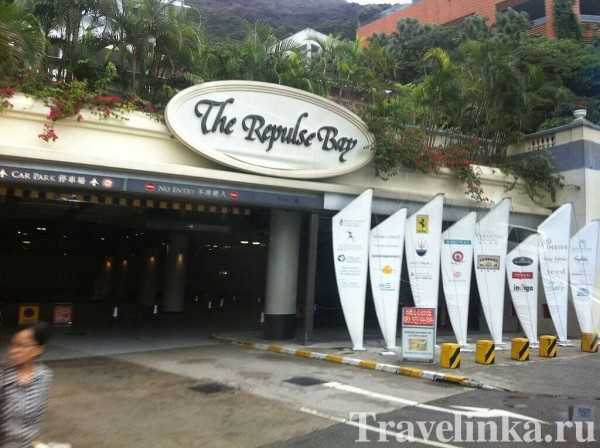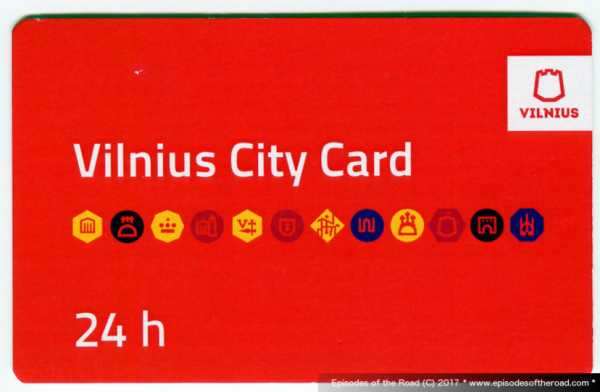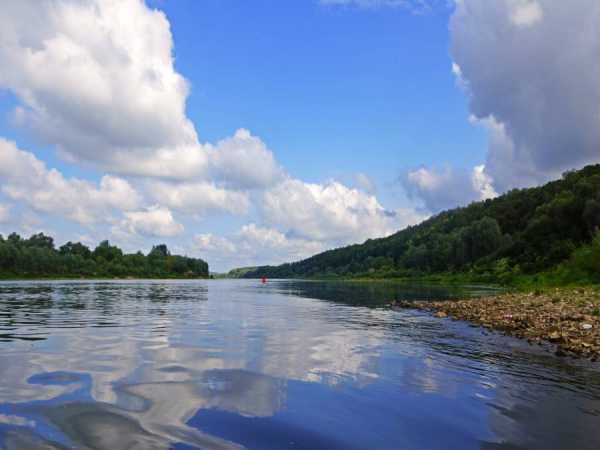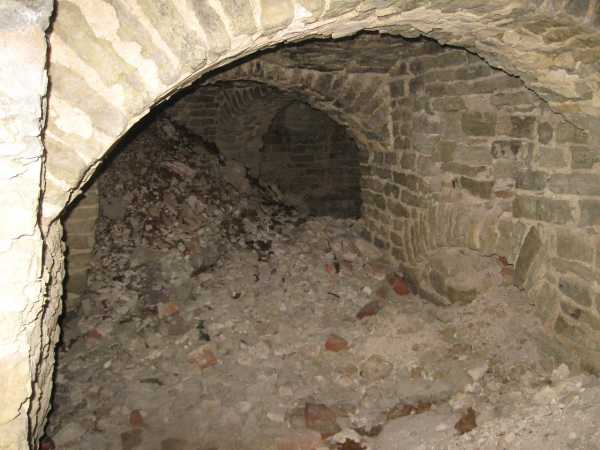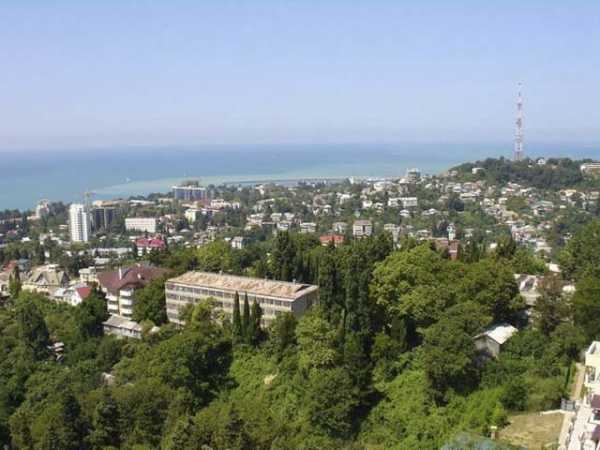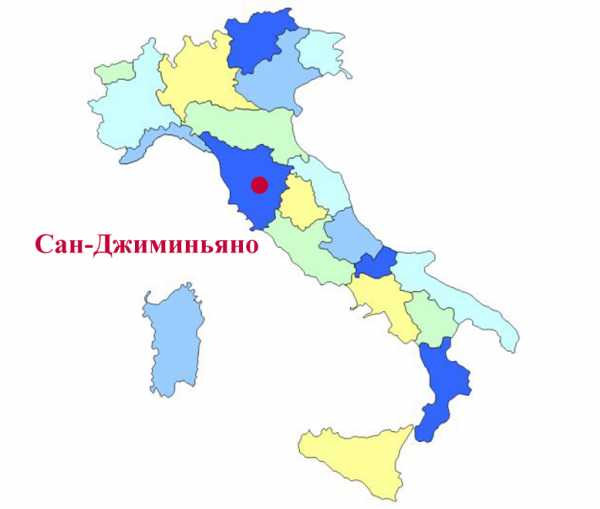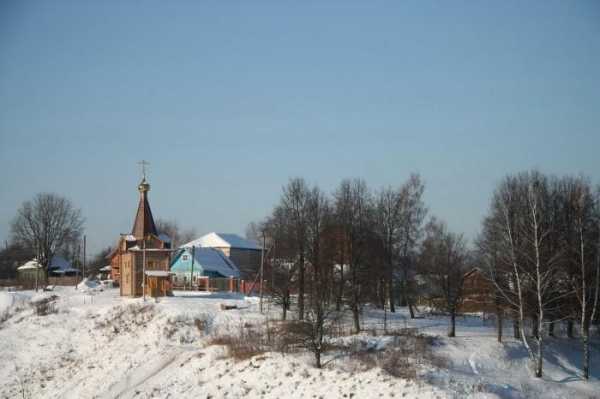 |
 |
 |
 |
|
Топик 561. (C). Мои любимые места в Белоруссии. Достопримечательности беларуси на английском языке с переводом
1hello.ru Minsk. Минск - Топик (тема) по английскому языку[08.06.2010] olga Посмотрели: 45678 Рейтинг: 11 Коментариев: 1 11MinskMinsk is the capital of the Republic of Belarus, its political, economic, cultural and scientific center. It is an ancient city and dates back to the 11th century. There is one version of how it came into being. Gleb Vseslavovich took proposition of Minsk from his father and made it the capital of an independent Principality. There are certain proofs that it was a flourishing commercial center located at the crossroads of the traditional trade rout from east to west and from north to south. Minsk is situated on the river Svisloch and occupies an area of 200 square kilometers. Its population is about 2 million people. During the Great Patriotic War Minsk was destroyed by German invaders almost completely. Minsk lay in ruins. The people of Belarus rebuilt the city. Victory Square, the Eternal Flame at the monument commemorates soldiers, underground fighters, partisans who fell in the battles for freedom f our motherland. The names of many streets of the city commemorate many heroes. The industrial enterprises of Minsk include: the Minsk Tractor Works, Minsk Computer Works, Ball-Bearing Plant, Refrigerator Plant, Watch Factory, and others. Industrial enterprises produce tractors and automobiles, motorcycles and bicycles, TV sets, radio-sets, watches and refrigerators, electronic computers, textile, footwear, food and other goods. It is also a big traffic center with a large network of railways, roads, air lines and two Metro lines. The Minsk Metro is the newest and very beautiful. Each station has some associations with historical events of the country or reflects the peaceful efforts of the people. Minsk is also known as a city of science and students. There is the Academy of Sciences and 16 higher educational establishments there, the biggest of which are the University and the Polytechnic Academy. The city is noted for it's varied interesting cultural life. In Minsk there are 6 theaters, concert halls, a circus, dozens of cinemas, many places of culture, libraries, clubs. The most famous theaters are the Opera and Ballet theatre, the Yanka Kupala Theatre, the Gorky Russian Drama Theatre. Among the most interesting museums one can mention the Museum of the History of the Great Patriotic War, the Art Museum and Yanka Kupala and Yakub Kolas Museums. The Art Museum is a real treasure-house of fine arts. Minsk is a city of sports. There are good recreation and sports facilities: tennis courts, playgrounds, swimming pools in various parts of the city. The main sports structures are: the Dynamo Stadium, the Palace of Sports and Water Sports Centre. МинскМинск является столицей Республики Беларусь, ее политическим, экономический, культурным и научным центром. Это древний город, который восходит к 11 веку. Существует версия того, как он возник. Глеб Всеславович принял предложение Минска от своего отца и сделал его столицей независимого княжества. Есть доказательства того, что это был процветающий коммерческий центр, расположенный на пересечении традиционных торговых путей с востока на запад и с севера на юг. Минск расположен на берегу реки Свислочь и занимает площадь 200 квадратных километров. Его население составляет около 2 миллионов человек. Во время Великой Отечественной войны Минск был разрушен немецкими захватчиками почти полностью. Минск лежал в руинах. Народ Беларуси восстановили город. На Площади Победы горит Вечный огнь у памятника в память о солдатах, подпольщиках и партизан, павших в боях за свободу нашей Родины. Названия многих улиц города носят имена героев. Промышленные предприятия Минска включают: Минский тракторный завод, Минский компьютерный завод, Шарико-подшипниковый завод, завод холодильников, часовой завод и другие. Промышленные предприятия производят трактора и автомобили, мотоциклы и велосипеды, телевизоры, радиоприборы, часы и рефрижераторы, электронно-вычислительную технику, текстиль, обувь, продукты питания и другие товары. Кроме того, это большой транспортный центр с большой сетью железных и автомобильных дорог, воздушных линий и 2 линий метро. Минское Метро является самым новым и очень красивым. Каждая станция имеет некоторые ассоциации с историческими событиями в стране и отражает мирные усилия народа. Минск также известен как город науки и студенчества. Здесь находится Академия наук и 16 высших учебных заведений, самыми большими из которых являются Университет и Политехническая академия. Город отмечен интересной культурной жизнью. В Минске есть 6 театров, концертные залы, цирк, множество кинотеатров, много мест культуры, библиотек, клубов. Самые известные театры- Театр оперы и балета, Театр имени Янки Купалы, Театр русской драмы им Горького. Среди наиболее интересных музеев можно упомянуть Музей истории Великой Отечественной войны, Художественный музей и музеи Янки Купалы и Якуба Коласа. Художественный музей - настоящая сокровищница изобразительного искусства. Минск- город спорта. В различных частях города есть хорошие рекреативные и спортивные сооружения: теннисные корты, детские площадки, плавательные бассейны. Главные спортивные структуры: Стадион "Динамо", Дворец спорта и Центр водных видов спорта. engmaster.ru The Republic of Belarus - топик на английскомThe Republic of Belarus is situated in the centre of Europe. It borders on Latvia, Lithuania, the Ukraine, Russia and Poland. Its territory is much larger than such countries as Austria, Belgium, Bulgaria, Greece and a number of others. Its present population is about 12 million people. Belarus is a land of vast plains and picturesque hills, thick forests and green meadows, deep blue lakes and flowing rivers. Forests cover 2/5 of Belarus, they are scattered all over the country. There are a lot of rivers and lakes in our country. The Dnieper, Pripyat, Beresins, Sozh, Zapadnaya Dvina, Neman are the biggest rivers with more then 500 kilometers in length. The largest lake in Belarus is Lake Naroch which stretches 13 kilometers from West to East. It is a very popular recreation area in our country. Belarus has a moderately continental climate due to the influence of the Atlantic Ocean with a warm winter and warm summer. To most of the world, Belarus is thought of as a relatively new country in Central Europe. For Belorussians, it's an ancient land. The history of Belarus goes back to ancient times beginning with the Polotsk Principality in the 10th century. From the 13th century until the 16th centuiy the territory of present -day Belarus was the core of the Grand Duchy of Lithuania in which Belarussian was the official language. It was one of the largest, most powerful and flourishing states, in Eastern Europe. The 16th century is considered to be the Golden Age of Belarussian history. This period was marked by prolific growth and foundation of many new cities and towns. There was significant progress in the development of culture and economy of the Belarussian people. As Belarus is situated in the centre of Europe many wars took place on its territory. One of the worst wars was in 1812 when French emperor Napoleon attacked Russia and as a result, Belarussian lands became a major battlefield arena. A great number of Belarussians took part in this war against Napoleon. In the 20th century alone Belarus survived three revolutions and three bloody wars. The Great Patriotic War of 1941-1945 was one of the most heroic and tragic periods in the history of the century. For three years the territory of Belarus was occupied by the Nazis. The country lost more than 3 million people (every third citizen fell in the fight against fascism), many towns and villages were ruined. Belarus lost more then half of its national wealth. Today Belarus is a developed industrial state. Industry makes up 70% of the Gross National Product. The main industries are engineering, chemical industry, wood-working industry, light and food industries. The major industrial centres in Belarus are Minsk, Gomel, Vitebsk, Mogilev, Soligorsk, Zhodino, Brest and others. Belarussian goods are exported to many countries and are known all over the world. Belarussian agriculture specializes in milk and meat production, flax, vegetables (especially potatoes) and fruit (especially apples). The Republic of Belarus has a well-developed science and educational system. The Academy of Sciences founded in 1929 is one of the largest centres of science in our country. Its research-institutes work on various important problems in such fields as mathematics, optics, genetics, biology, etc. The demand for higher education remains high. State institutions are the centres both for education and scientific research. Nowadays in Belarus there are 43 universities, academies and institutes which provide training in various spheres of science and humanities. At present Belarus actively participates in an effective international partnership with the governments of different states and international organizations. As a co-founder of the United Nations, Belarus cooperates with various institutions and organizations of the United Nations, World Bank, World Health Organization, International Labor Organization, UNESCO, the European Union, etc. Belarus has a friendly working relationship with such countries as Germany, Denmark, France, Canada, Italy, Netherlands, Sweden, Great Britain, The USA and many others. www.native-english.ru Достопримечательности беларуси на английском - отдых и туризмBelarus. Республика Беларусь Belarus The republic of Belarus is situated in the center of Europe on the watershed of the Baltic and Black Seas. The capital is Minsk. Belarus borders on Poland, Lithuania, Latvia, Russia and Ukraine. The total length of the state border makes up 2,969 km. Geographic and climatic conditions favor the development of transport and economic relations. The shortest ways from Russia to Western Europe and from the Baltic Sea to the Black sea run through Belarus. The territory of Belarus is 207.6 thousand sq km. It stretches from west to east for 650 km and from north to south for 560 km. The country’s relief is flat with hills. The climate of Belarus is moderate continental with mild and humid winters, warm summers and damp autumns. Forests constitute 33 % of the country’s area. In Belarus there are over 20 thousand rivers and lakes. The largest lake is Naroch. The navigation is carried out on the rivers Pripiats, Dnieper, Neman, Berezina and Western Dvina. Belarus consists of 6 regions: the Brest, Vitebsk, Gomel, Grodno, Minsk and Mogiliov regions. Minsk, the capital, is one of the most beautiful cities in Europe. The industrial potential of Belarus includes 20 thermoelectric power stations, 17 metallurgical works, 70 petrochemical plants (the concern “Belneftekhim”), 29 machine-tool construction enterprises, 36 automakers and so on. According to recent researches the number of small enterprises has exceeded 30 thousand. 6 economic zones are established. Foreign enterprises are created with participation of 80 countries. The financial market is represented by the National bank of Belarus, 29 commercial banks and 10 foreign ones. 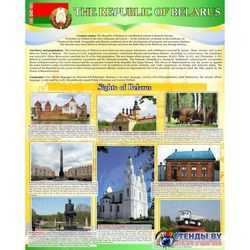 There are 27 state theaters, including opera and ballet theater, a musical comedy theater, etc. The Ministry of culture has 128 state museums. The sports facilities include almost 500 stadiums and swimming pools, more than 5000 outdoor sports grounds. In 2000 all regional centers had Ice palaces and skating rinks. Minsk citizens and all inhabitants of Byelorussia are especially proud of the new National Library being unique as in Europe, and all over the world. Беларусь Республика Беларусь расположена в центре Европы на водоразделе Балтийского и Черного Морей. Столица - город Минск. Белоруссия граничит c Польшей, Литвой, Латвией, Россией и Украиной. Общая протяженность государственной границы составляет 2,969 км. Географические и климатические условия способствуют развитию транспортных и экономических отношений. Кратчайшие пути из России до Западной Европы и от Балтийского моря до Черного моря проходят через Белоруссию. Общая территория Беларуси - 207.6 тысяч кв. км. Она простирается с запада на восток на 650 км и с севера на юг на 560 км. Рельеф страны плоский с холмами. Климат - умеренно-континентальный, зимы мягкие и влажные, летом тепло, а осенью сыро. Леса составляют 33 % области страны. В Белоруссии более 20 тысяч рек и озер. Самое большое озеро - Нарочь. Судоходны реки Припять, Днепр, Неман, Березина и Западная Двина. Белоруссия состоит из 6 областей: Брестской, Витебской, Гомельской, Гродненской, Минской и Могилевской. Минск, столица, является одним из наиболее красивых городов в Европе. 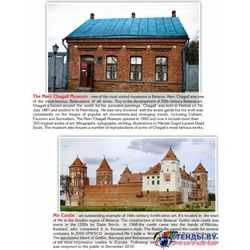 Индустриальный потенциал Белоруссии включает 20 термоэлектрических станций, 17 металлургических заводов, 70 нефтехимических заводов (предприятие "Белнефтехим"), 29 машиностроительных предприятий, 36 автомобилестроительных и так далее. Согласно недавним исследованиям число малых предприятий превысило 30 тысяч. Установлено 6 экономических зон, иностранные предприятия созданы с участием 80 стран. Финансовый рынок представлен Национальным банком Белоруссии, 29 коммерческими банками и 10 иностранными. 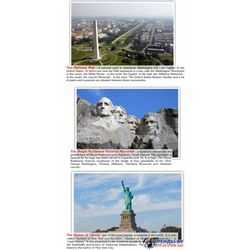 Есть 27 государственных театров, включая Театр Оперы и Балета, музыкальный комедии и др. Министерство культуры имеет 128 государственных музеев. Спортивные сооружения включают около 500 стадионов и бассейнов, почти 5000 наружных спортплощадок. В 2000 все региональные центры имели Ледяные дворцы и катки. Особой гордостью минчан и всех жителей Беларуси является новая Национальная Библиотека, являющаяся уникальной как в Европе, так и во всем мире. Bělorusko - Belarus - Беларусь - Minsk - Минск 2011tour-rizm.ru Топик 561. (C). Мои любимые места в БелоруссииЕвтух Дмитрий. Гимназия №4, Минск, БелоруссияСочинение на английском языке (топик по английскому языку) I`d like to start with some facts about Belarus. It has an area of 207600 square kilometers and the population of more than nine million. In my view, most of the people here are open-minded, kind, hard-working and hospitable. Belarus is situated in Eastern Europe and has endured two world wars. Russia, Ukraine, Poland, Lithuania and Latvia are our neighbors. Our relations with all countries are friendly, equal in rights. People of various countries have left their traces here. The first people came to Belarus twenty four thousand years ago. Uravichi and Berdish were the first settlements here. The original Belorussian tribes are Krivichi, Radzimichi and Drygovichi. In the old times, people called Belarus the country of castles. There were 34-40 km between the castles. Now there are many places in Belarus where we can still see castles, churches and cathedrals. Strange as it may seem, but they attract me very much. Nesvizh is one of the oldest historical and cultural towns in Belarus. The greatest cultural value in Nesvizh is Nesvizh castle. Since the sixteenth century it has been the residence of the Radzivils family. The castle has been under reconstruction for the last seven years. It is in the UNESCO World Heritage List. Not far from Nesvizh castle we can find Mir castle. Mir is older than Nesvizh. It dates back to the sixteenth century. The castles are very interesting and I`ve visited them. They are famous for their ghosts and legends. Nesvizh ghosts are Black Dame and Black Nun. Black Nun likes to play tricks on people. The ghost can push someone or break a mirror. I`d like to be a witness of something like that. I would be afraid of meeting her, but I`d like to. Black Dame still walks in the castle. It`s the ghost of Barbara Radzivil. And now I can`t but attract your attention to our capital. The first mentioning of Minsk can be found in chronicles in 1067 year. In 1067 there was fight at the Nemiga. In 1129, Minsk principality became part of Kiev principality. In general, at this time Minsk was a strong and rich city, because two big roads passed through it. Belarus became a part of Russia. But I want to tell you about just one thing the history of my native city. My favorite place in Minsk is Troitskoe Suburb. It is a picturesque and unique place of old Minsk which is one of the favorite places for the rest of citizens of Minsk and visitors to the capital. The settling of this territory according to the archaeological data began in the twelfth century. At the beginning of 16th century, the towers of Troitskaya church and a monastery rose on a hill. The mountain Troitskaya in the MiddleAges fulfilled the function of a defensive redoubt on the approaches to the city. According to written sources, in 1605 the main street of the suburb was Troitskaya, which began at the bridge over the Svislach. When Belarus was part of Russian Empire, it was called Aleksandrovskaya, during Soviet times, Maxim Gorky street, and now it has the name of the well-known Belarusian poet Maxim Bogdanovich who was born in one of the houses in this street. The majority of the houses in Troitskoe suburb were wooden and considered as the suburb of Minsk, nowadays it is the centre of the city. In 1840, instead of the Catholic monastery an orthodox theological seminary was placed in the building. Now greatly reconstructed, this monastic building is occupied by Suvorov school. The fire of 1809 destroyed all wooden construction of Suburb Troitskoe. Then it was rebuilt. It was subordinate to the canons of classicism, according to which all the streets of the city should cross in the right angle, creating square and rectangular quarters. Stone houses in the streets were put closely to each other, creating a uniform line with the common faзade. The architects took into account local traditions which where expressed in a characteristic ornament of faзades, and the climatic conditions caused high roofs with attics and penthouses for economic needs. The Troitskoe suburb looks like this now. Its restoration according to old plans, drawings and photos was done in 1980. Why do I like this place` Because modern building such as the Opera and Ballet House, a set of museums, showrooms and other cultural are in harmony with old buildings, whereas the interior of the bookstores, cafes and shops in the suburb contain the spirit of past. I and my classmates often come here to have a good time and a good rest. In my opinion, it`s so catching and exciting to study the history of my native country, to reveal the secrets and mysteries of the place where I was born and live. I believe that every place in the world is unique and has something to tell us. So I advise everybody to start a journey to the history of your native land. I`m sure you can enjoy it and have some adventures. Good luck!
Copyright © Russian centres of City and Guilds
english-exam.ru Topic Belarus ( Топик на английском языке Белоруссия)
Topic Belarus — Топик на английском языке Беларусь (Белоруссия)Have you ever asked yourself a seemingly simple question: «Why and what for do I love my country?» I’m sure you’ll find enormous difficulty trying to give a proper answer.There’s hardly anyone, who will be positive about the matter.There’s hardly anyone, who will sense the matter in its entirety.There’s hardly anyone, who’ll be able to describe the blue of the sky, or the peculiar flavor of the home wind, or the specific softness of the native soil, or the inexpressible beauty of the people around us. What we shall probably be able to say, is that it all belongs to us and that is where we belong. And we can claim that it all has been given to us by God. And God along can take it away from us.You know, I was born in Belarus and have lived here ever since. Why is Belarus called Belarus? You see, in the 1 3th century the territory of present Belarus was free from Tatar- Mongol yoke, and that part was called Byelaya Russ, because in ancient times to be «white» meant to be «free». It’s also known that the locals were dressed in white clothes made of flax and had blonde hair, so some historians put the name of our native land down to these facts.Not without a reason did Vladimir Karatkevich sing a song of praise to our Motherland and call it «a fairy-tale country», since the landscape of Belarus is really picturesque. Our native land is remarkably beautiful with its endless expanses of fields, meadows and swamp, with its varied and plentiful animal and plant kingdom. As far as the eye can see, a gently rolling patchwork of fields, interspersed by pockets of woodland, stretches into the distance. Everything, it seems, is a pleasant shade of green. The surprising thing is that for such a small country, providing home for some 10 mln people, is has so much open space. The weather is beautiful, the atmosphere is clear and the late afternoon light is warm and magical. Another poetic name that suits our country very much is «the land beneath white wings». It is so, because the stork is the symbol of Belarus. Their nests are seen everywhere. Vladimir Muliavin even dedicated one of his ballads to them and called it «A bird’s cry». When it’s being performed the spectators are completely absorbed in the dramatic atmosphere of the song and stay in dead silence till the end. Furthermore, you can hear their overwhelmingfarewell cry at the end of October each year.One more name that our country has gained for a good reason is «a blue-eyed land». It’s called so due to its pale blue lakes and ribbons of rivers. Belarus can boast some 3000 rivers and 10000 lakes. Lake Naroch is the biggest one, while Lake Svitsas is the gem of Belarusianlakes. One can’t help admiring the marvelous beauty of it and its delightful surroundings.Adam Mitskevich dedicated his poem to this lake. According to a legend a village disappeared in its water long ago.Thanks to vastly stretching forests our country is called «the land of woods». The most widespread example is its national reservation — Belovezhskaya Puscha. It’s not just a woodland, it’s as it’s called puscha. This word is one of the most expressive and euphonic in the Belarusian language. This word makes the listener imagine a primeval forest which has preserved its prehistoric nature. The Puscha is fully covered with ancient forests. It’s the area of outstanding natural beauty. Wild dear still roams the park. It also has an impressive number of bird species. But the unquestionable king there is the European bison, which strikes the visitors by its unlimited power and strength. One can enjoy listening to the everlasting noise of tsar-oaks and feast your eye on golden pine woods, where mushrooms made themselves comfortable. By the way, Belovezhskava Puscha is included into the UNESCO list of The World’s heritage sites.Need I say that Belarus has a complex and fascinating history. When learning history as a child, I remember thinking about courageous knights and elegant ladies. But in reality, Belarusian history is much more complicated. A great number of wars were held there, after each it was left in utter ruins. But each time it rose from the ashes like a mythical bird Phoenix.Due to our historical past, there are still gloomy ruins of castles, sunny palaces, magnif¬icent cathedrals which add to the beauty of our republic. Take the Mir Castle for example, which is situated in Grodno region. Seeing it you’ll be absorbed from head to toe in the impressive sight of the castle and its stunning surroundings.Talking about present-day Belarus, I can’t but say a few words about this well-developed country, its education and culture.Nowadays Belarus can take pride in its high-quality products such as: tractors and lorries, dairy products and bicycles, mineral fertilizers and synthetic fiber, mineral oil and furniture. Belarusian goods are well-sold not only in the republic itself, but on the world market as well.Scientific and intellectual potential is the strategic resource of our country. There are a good many educational establishments in Belarus. The republic is reforming its educational system today with a view to creating a new national school, corresponding to international standards and ensuring each and every citizen the right to high-quality education according to their abilities.What I love most about my Motherland is that so much attention is paid to growing souls. Sport clubs and various organizations for talented youth are being established with striking frequency. In other words, if you are born a gifted kid in Belarus, be sure your talents will be developed. There are numerous youth organizations in Belarus. Apparently, the most popular is the Belarusian Union of Youth. The main goal of it is to unite patriotically thinking young people for active participation in social life.And to complete the picture I would like to mention, that the Belarusians take great pride in their cultural heritage and keep their traditions thoroughly. If you want to experience real joy — the joy that isn’t spoilt by falling snow and severe frost, you should come to Belarus, when Kalyady is being celebrated. And if you want to live a long and happy life, come here in July and join hundreds of young people who are seeking for the fern-flower in the forest. I firmly believe, that it’s great that in the endeavour to reassert their national identity young people are eager to revive the national customs and traditions.All in all, what does it mean «I love my country»? I’m inclined to think, to love my motherland means knowing its history, taking interest in what’s going on in it, preserve its national language and being useful to it. I understand, that a man isn’t like a mushroom growing by the side of the road. I’m a person and I am not so easily uprooted from my birthplace and crushed, because I have my Homeland. Поставь свою оценку ! Загрузка... Книги на английском - словарный запас с удовольствием Книги на английском - словарный запас с удовольствием  Лучшие методы изучения английского языка Лучшие методы изучения английского языка  Самый простой и эффективный способ выучить английский Самый простой и эффективный способ выучить английский lelang.ru Топик по английскому "Республика Беларусь" (Belarus)The republic of Belarus is situated in the center of Europe on the watershed of the Baltic and Black Seas. The capital is Minsk. Belarus borders on Poland, Lithuania, Latvia, Russia and Ukraine. The total length of the state border makes up 2,969 km. Geographic and climatic conditions favor the development of transport and economic relations. The shortest ways from Russia to Western Europe and from the Baltic Sea to the Black sea run through Belarus.
The territory of Belarus is 207.6 thousand sq km. It stretches from west to east for 650 km and from north to south for 560 km.
The country’s relief is flat with hills. The climate of Belarus is moderate continental with mild and humid winters, warm summers and damp autumns.
Forests constitute 33 % of the country’s area. In Belarus there are over 20 thousand rivers and lakes. The largest lake is Naroch. The navigation is carried out on the rivers Pripiats, Dnieper, Neman, Berezina and Western Dvina.
Belarus consists of 6 regions: the Brest, Vitebsk, Gomel, Grodno, Minsk and Mogilev regions. Minsk, the capital, is one of the most beautiful cities in Europe.
The industrial potential of Belarus includes 20 thermoelectric power stations, 17 metallurgical works, 70 petrochemical plants (the concern “Belneftekhim”), 29 machine-tool construction enterprises, 36 automakers and so on. According to recent researches the number of small enterprises has exceeded 30 thousand. 6 economic zones are established. Foreign enterprises are created with participation of 80 countries.
The financial market is represented by the National bank of Belarus, 29 commercial banks and 10 foreign ones.
There are 27 state theaters, including opera and ballet theater, a musical comedy theater, etc. The Ministry of culture has 128 state museums. The sports facilities include almost 500 stadiums and swimming pools, more than 5000 outdoor sports grounds. In 2000 all regional centers had Ice palaces and skating rinks.
Minsk citizens and all inhabitants of Byelorussia are especially proud of the new National Library being unique as in Europe, and all over the world.
Перевод
Республика Беларусь расположена в центре Европы на водоразделе Балтийского и Черного Морей. Столица — город Минск. Белоруссия граничит c Польшей, Литвой, Латвией, Россией и Украиной. Общая протяженность государственной границы составляет 2,969 км. Географические и климатические условия способствуют развитию транспортных и экономических отношений. Кратчайшие пути из России до Западной Европы и от Балтийского моря до Черного моря проходят через Белоруссию.
Общая территория Беларуси — 207.6 тысяч кв. км. Она простирается с запада на восток на 650 км и с севера на юг на 560 км.
Рельеф страны плоский с холмами. Климат — умеренно-континентальный, зимы мягкие и влажные, летом тепло, а осенью сыро.
Леса составляют 33 % области страны. В Белоруссии более 20 тысяч рек и озер. Самое большое озеро — Нарочь. Судоходны реки Припять, Днепр, Неман, Березина и Западная Двина.
Белоруссия состоит из 6 областей: Брестской, Витебской, Гомельской, Гродненской, Минской и Могилевской. Минск, столица, является одним из наиболее красивых городов в Европе.
Индустриальный потенциал Белоруссии включает 20 термоэлектрических станций, 17 металлургических заводов, 70 нефтехимических заводов (предприятие "Белнефтехим"), 29 машиностроительных предприятий, 36 автомобилестроительных и так далее. Согласно недавним исследованиям число малых предприятий превысило 30 тысяч. Установлено 6 экономических зон, иностранные предприятия созданы с участием 80 стран.
Финансовый рынок представлен Национальным банком Белоруссии, 29 коммерческими банками и 10 иностранными.
Есть 27 государственных театров, включая Театр Оперы и Балета, музыкальный комедии и др. Министерство культуры имеет 128 государственных музеев. Спортивные сооружения включают около 500 стадионов и бассейнов, почти 5000 наружных спортплощадок. В 2000 все региональные центры имели Ледяные дворцы и катки.
Особой гордостью минчан и всех жителей Беларуси является новая Национальная Библиотека, являющаяся уникальной как в Европе, так и во всем мире.
продолжить с темой "Страны и города" >>>
вернуться к списку тем топиков >>>
Если Вам понравилось — поделитесь с друзьями :
Присоединяйтесь к нам в Facebook! Изучение разговорного английского — Real Language Club Смотрите также: Самое необходимое из теории языка: Предлагаем пройти тесты онлайн: Рекомендуемые статьи и видео: Ещё статьи >>> reallanguage.club |
| © vpoisketurov.ru (СЃ) 2022 Предложения лучших туроператоров |
